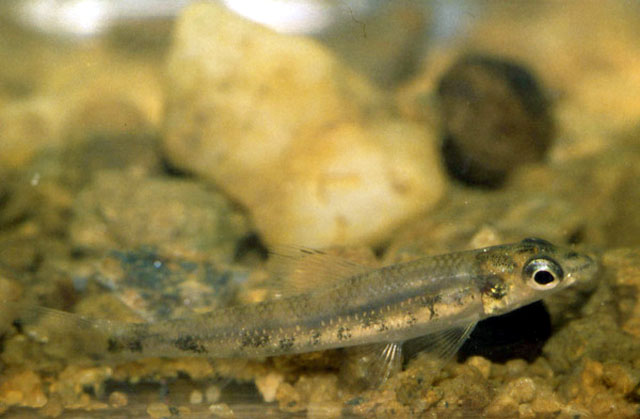| Distichodontidae (Distichodus) |
| 6.6 cm SL (male/unsexed) |
|
pelagic; freshwater; pH range: 6 - 7.5; dH range: 7 - 15, potamodromous |
| Africa: widespread, known from Senegal to Cameroon, including the Lake Chad basin (Ref. 2936, 80507, 81638, 86396). Also in the Dja and Bumba rivers (middle Congo River basin) in Cameroon (Ref. 46233). Reported from Ntem and Kribi Rivers (Ref. 51193), but not confirmed in Ref. 81638. Holotype from Gabon (Ref. 93570), without further specifications. |
|
Dorsal spines (total): 0-0; Dorsal soft rays (total): 11-14; Anal spines: 0-0; Anal soft rays: 8-12. Diagnosis: body slightly elongate; head length 3.7-4.3x SL; 2.5-6 scales between anus and anal-fin base; 12-16 scales around caudal peduncle; 12-18 pectoral branched rays; 8-10 pelvic branched rays; series of separate spots along lateral line, not always distinct (frequently suffused by marbled color pattern on sides); scale formula 4-5.5/40-46 (Ref. 2936, 86396). 43-46 pored (except terminal 1-2) lateral line scales (Ref. 81638). Tip of pelvic fin extending distinctly beyond vent; dorsal portions of body with distinct dark, vertically oriented dark marks forming saddle-shaped pigmentation pattern; various dark marks on lateral surface of body without prominent, horizontally elongate dark spots on mid-lateral surface of body; dark pigmentation on body above horizontal through base of pectoral fin (Ref. 81638). 12-14 (Ref. 81638) or 11-14 (Ref. 2936, 86396) total dorsal fin branched rays. 10-12 (Ref. 81638) or 8-12 (Ref. 2936, 86396) total anal fin branched rays.
Description: snout blunt; body rather subcylindrical in cross-section; eyes in lateral position (Ref. 2936, 86396). Body depth 0.16-0.19x SL and distinctly flattened ventrally along underside of head and chest; mouth subterminal with single row of bicuspid teeth in each jaw; premaxilla and dentary with 4-5 teeth; maxilla edentulous; lower jaw width posteriorly approximately equal to one-half orbital height in larger specimens; pelvic fin with middle rays in larger specimens distinctly produced; adipose fin usually present, sometimes absent; body scales ctenoid and of moderate size; lateral line scales completely pored in larger specimens other than for terminal 1-2; 4-5 scales between anal fin origin and lateral line; D: II-III,10-11 and A: II-III,8-9 (Ref. 81638). 6-11 scales between posterior end of adipose fin to caudal fin base (Ref. 2936, 86396).
Coloration: preserved specimens tan, darker dorsally; horizontal band from tip of snout to anterior margin of orbit, irregular dark pigmentation posterior to orbit; live specimens with pink fins and some with bright red lips (Ref. 81638). More details on fin coloration in preserved specimens can be found in Ref. 81638. |
| Maximum TL was recorded at 7.8 cm (Ref. 7094). Feeds on small invertebrates (Ref. 13614). |
|
Least Concern (LC); Date assessed: 01 November 2019 Ref. (130435)
|
| harmless |
Source and more info: www.fishbase.org. For personal, classroom, and other internal use only. Not for publication.

